Restorative Dentistry
ORTHOGNATHIC SURGERY | CORRECTIVE JAW SURGERY
When there is slight or moderate tooth decay, i.e. decay is only limited to the enamel or dentine, then decay can be removed and the tooth can be restored with tooth colored filling.
When tooth decay (dental caries) is extensive and has progressed deeper into the tooth, it reaches the pulp chamber affecting the nerves and blood vessels. Such conditions may cause severe toothache, difficulty in biting, chewing and if not intervened, it may even cause swelling and infection around the tooth.

ORTHOGNATHIC SURGERY | CORRECTIVE JAW SURGERY
The pulp space is disinfected and filled with a permanent, inert material to salvage the tooth and normal functioning.
STEPS INVOLVED IN ROOT CANAL TREATMENT

A. Decayed tooth with pulpal infection
B. Removing caries and opening the root canal
C. Removing the infected pulp and cleaning the canal with advanced endodontic kid’s rotary file.
D. Root Canals are filled with calcium hydroxide and Iodoform paste.
E. Entrance filling is given.
F. Stainless steel crown is placed on the tooth.
ORTHOGNATHIC SURGERY | CORRECTIVE JAW SURGERY
In cases where a tooth has been infected for a very long time & no treatment has been sought, there may develop a severe infection at the root tip. In such cases, an apicoectomy may be done. In this procedure, the gum tissue near the tooth is opened to see the underlying bone and to remove any infected tissue. The infected portion of the root-tip is also removed and the root canal sealed completely to ensure no seepage of infection into the canal.


